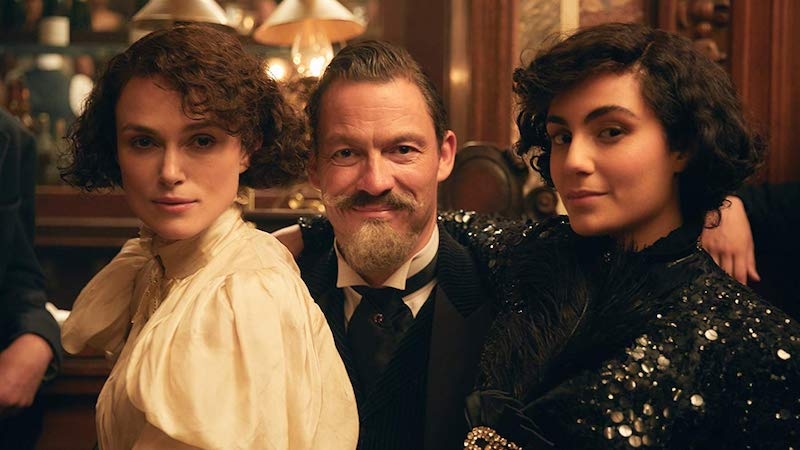
There is something incessantly captivating about the whole thought that before the blitzkrieg of feminism in our society, there lived a woman called Colette in the early twentieth century. One who is an amalgam of beautiful contradictions, Sidonie-Gabrielle Colette (played by Keira Knightley) is a woman of autonomy. She lets her husband Henry “Willy” Gauthier-Villars control her movements but only to the extent that she wanted him to. Directed by Wash Westmoreland, Colette chronicles the volatile early life of the iconic woman who had seen it all by the time she turned 30.
Often pictured as a portrait of countryside quaintness, Gabrielle’s Burgundian childhood bred enough juice for an exotic story – on and off the pages meant for public consumption. The lissome lass marries the 14-year elder Willy (Dominic West) who is a bourgeois writer based in Paris. Concealing Willy’s mediocrity was his capricious persona, extravagant lifestyle, and manipulative methods to stay relevant. When bankruptcy hits him hard, Willy orders his wife that she writes. One with a natural penchant for the pen, Colette leisurely takes up the challenge and creates a character that goes on to become a household name in France – Claudine. This is despite facing brutal rejection from her haughty husband in the past with regards to her ability to engage a reader.
“I am the real Claudine,” claimed many a Parisian woman, much to Willy and Colette’s glee. Long before entities from literature and cinema could become pronounced brands by themselves, there she was on every makeup box, cigar tray, bathing soap, and folding fan. The difference lay in how Claudine had varying meanings for its creators. For Willy, she was a ‘goose’ while for Colette it was their child, or at least hers. It is only after she faces severe disappointment from her man over the same that she leaves him for good.
ALSO READ: ‘Manto’ review – recording the life and times of a liberal icon
From what the screenplay (Wash Westmoreland, Rebecca Lenkiewicz, Richard Glatzer) wants us to believe, Willy comes across as an egoistic megalomaniac for whom power equations meant a lot more than relationships of merit. As individuals who contrasted in belief systems, Colette could subscribe to Willy’s ways with a nonchalant air of denial, which was also a sign of compliance that came purely by choice. Willy, on his part, encourages Colette’s transitory affairs with other women, with an eye for perspective literary material. For Willy, Colette graduated to become the goose, as opposed to Claudine. His indulgence, arrogance, aristocracy – all were patented to ideas that germinated from Colette’s mindscape. This also makes Willy a hard act to nail, which Dominic West does to precision with a conclusive air of self-assurance as he lends legitimacy to a marriage that was more of a vicious business deal.
Westmoreland’s design for the film is notably magnificent with the cinematography presenting a sumptuous visual feast. With an obsession for reflections, Giles Nuttgens shoots the film as if it were to match the vintage paintings from the era. The original score by Thomas Adès is atmospheric and adds a fine layer of drama to the proceedings that are driven prominently by high-octane exchanges, ornate costumes, and production design. The dialogues are often crafted to examine the character psyches with great beauty. “I wonder if there will come a time when you must decide, are you Claudine or Colette,” asserts Gabrielle’s lover Missy (Denise Gough, acing the homosexual act in style). I was not particularly amused by the time transitions as the film in entirety represents only a short period in Colette’s expansive, eventful life.
The biggest delight from Colette, nevertheless, is a towering, unabashed lead performance by Keira Knightley who owns every frame with astute poise. Notice her disregard when she uses Willy’s repartee back at him, “The hand that holds the pen writes history.” You also perceive how acquiescent Gabrielle is to Willy’s unfair, dominating ways. Yet, Knightly walks the thin line of conviction to make us identify with a woman who took eons to call it quits. This might come as a jolt in times of ‘Me Too’. However, when you look at the era and what it traditionally held for women, Gabrielle’s abstinence stands largely justified.
As the film satisfyingly ends on a high note, one wonders if it holds promise for a compelling sequel. After all, there is a lot more to Colette and what we see in the film is a precursor to what eventually went on to be a productive and momentous life. For the rest, Westmoreland’s representation of quiet rebellion and coming-of-age [also sexually] in an era of radicalism serves justice to its subject who also became a symbol of feminism, almost by accident.
Rating: ★★★ 1/2
Colette can now be watched on Netflix.

